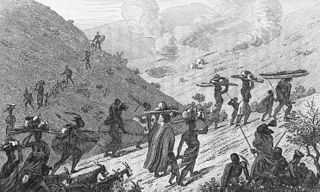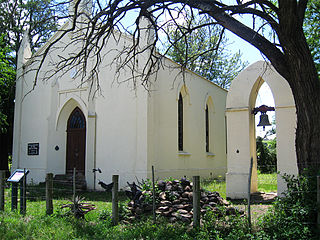| |||||||||
| Decades: | |||||||||
|---|---|---|---|---|---|---|---|---|---|
| See also: | |||||||||
The following lists events that happened during 1851 in South Africa .
| |||||||||
| Decades: | |||||||||
|---|---|---|---|---|---|---|---|---|---|
| See also: | |||||||||
The following lists events that happened during 1851 in South Africa .

Boers is the term used for the descendants of the Dutch-speaking Free Burghers of the eastern Cape frontier in Southern Africa during the 17th, 18th and 19th centuries. From 1652 to 1795, the Dutch East India Company controlled this area, but the United Kingdom incorporated it into the British Empire in 1806. The name of the group is derived from "boer", which means "farmer" in Dutch and Afrikaans.

Mahikeng, formerly known as Mafikeng and alternatively known as Mafeking, is the capital city of the North West province of South Africa.

The Cape Colony, also known as the Cape of Good Hope, was a British colony in present-day South Africa named after the Cape of Good Hope. It existed from 1795 to 1802, and again from 1806 to 1910, when it united with three other colonies to form the Union of South Africa, then became the Cape Province, which existed even after 1961, when South Africa had become a republic, albeit, temporarily outside the Commonwealth of Nations (1961-94).

The Griquas are a subgroup of mixed race heterogeneous former Khoe-speaking nations in Southern Africa with a unique origin in the early history of the Dutch Cape Colony. Under apartheid, they were given a special racial classification under the broader category of "Coloured". They are Cape Coloureds who participated in the Great Trek, forming "Griqua States".

Vryburg is a large agricultural town with a population of 48,400 situated in the Dr Ruth Segomotsi Mompati District Municipality of the North West Province of South Africa. It is the seat and the industrial and agricultural heartland of the district of the Bophirima region.
The following lists events that happened during 1841 in South Africa.

Kaffraria, Kaffiria, or Kaffirland was the descriptive name given to the southeast part of what is today the Eastern Cape of South Africa. Kaffraria, i.e. the land of the Kaffirs, is no longer an official designation.

The amaMfengu was a reference of Xhosa clans whose ancestors were refugees that fled from the Mfecane in the early-mid 19th century to seek land and protection from the Xhosa. These refugees were assimilated into the Xhosa nation and were officially recognized by the then king, Hintsa. The term derives from the Xhosa verb "ukumfenguza" which means to wander about seeking service.

Alice is a small town in Eastern Cape, South Africa that is named after Princess Alice, the daughter of the British Queen Victoria. It was settled in 1824 by British colonists. It is adjacent to the Tyhume River. It has a rail and road connection to East London, Qonce and other towns in the province.

Stutterheim is a town with a population of 46,730 in South Africa, situated in the Border region of the Eastern Cape province. It is named after Richard Von Stutterheim.
Fort Hare was an 1835 British-built fort on a rocky outcrop at the foothills of the Amatola Mountains; close to the present day town of Alice, Eastern Cape in South Africa.
The United Congregational Church in Southern Africa began with the work of the London Missionary Society, who sent missionaries like Dr. Theodorus van der Kemp to the Cape colony in 1799. He was established the first Congregational church in Cape Town in 1801. LMS missionaries like David Livingstone spread the Gospel among the Batswana and Amandbele peoples. After 1820 English and Welsh settlers established their own congregational congregations. Congregationalist missionaries from the American Board of Commissioners for Foreign Missions began work in KwaZulu-Natal in 1830, and several congregations of white settlers formed the Congregational Union of South Africa. These three bodies united to form the United Congregational Church of Southern Africa in 1967.
The Vicariate Apostolic of Natal was a Roman Catholic missionary, quasi-diocesan jurisdiction in South Africa.

William Anderson was an English Christian missionary who relocated to South Africa under the auspices of the London Missionary Society. He was one of the earliest missionaries in the region. Anderson was instrumental in the foundation of the South African town Griquatown.
Döhne is a South African agricultural research station 6 kilometres north of Stutterheim in the Eastern Cape. It is noted for having developed the Döhne Merino from Peppin Merino ewes and German mutton merino sires in 1939. The program bred for high fertility, rapid lamb growth and fine wool production under pastoral conditions. The breed was introduced to Australia in 1998.
Valentine Alexius Schoonberg a Bavarian retail merchant and/or a missionary based at the Cape of Good Hope in South Africa. He was suspected of being a co-conspirator with individual/s being held at the Castle after sentencing for capital crimes. He printed the first known book in the Cape, it is also the earliest known printed religious publication in South Africa. It was a translation, from English to Dutch, of a letter brought out in 1799 by Dr. J. T. van der Kemp of the London Missionary Society to their followers in the Cape, entitled "Brief van het Zendelings Genootschap te London aan de Godsdienst-lievende ingezetenen van de Caap de Goede Hoop".

Slavery in South Africa existed from 1653 in the Dutch Cape Colony until the abolition of slavery in the British Cape Colony on 1 January 1834. This followed the British banning the trade of slaves between colonies in 1807, with their emancipation by 1834. Beyond legal abolition, slavery continued in the Transvaal though a system of inboekstelsel.
Enon is a small town in the Eastern Cape in South Africa. It is named after the biblical place mentioned in John 3:23 It lies 13 kilometres (8.1 mi) east of Kirkwood and 60 kilometres (37 mi) north-east of Uitenhage.

Steinkopf is a town in Namakwa District Municipality in the Northern Cape province of South Africa.
German South Africans refers to South Africans who have full or partial German heritage.
See Years in South Africa for list of References